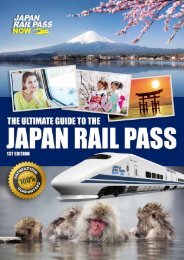Japan Rail Pass Now - Japan Travel Guide
Japan Travel Guide by Japan Rail Pass Now (www.japanrailpass.com.au)
Japan Travel Guide by Japan Rail Pass Now (www.japanrailpass.com.au)
Create successful ePaper yourself
Turn your PDF publications into a flip-book with our unique Google optimized e-Paper software.
Bullet Train & History<br />
In addition, several additional lines are planned over the coming decades. One magnetic line between Tokyo and Nagoya that is scheduled for<br />
completion by 2027 will enable Shinkansen trains to travel at speeds up to 500 kilometres per hour.<br />
A variety of Shinkansen train types operate on each existing line, ranging from express services that bypass various stations to those that stop<br />
at each station.<br />
Shinkansen <strong>Travel</strong> Time Between Popular Destinations<br />
●<br />
●<br />
●<br />
●<br />
●<br />
●<br />
Tokyo to Kyoto: 2 hours, 49 minutes<br />
Tokyo to Shin-Osaka: 2 hours, 33 minutes<br />
Tokyo to Akita: 3 hours, 50 minutes<br />
Shin-Osaka to Hiroshima: 1 hour, 40 minutes<br />
Hiroshima to Hakata: 1 hour, 8 minutes<br />
Hakata to Kagoshima: 1 hour, 17 minutes<br />
Seat Categories<br />
Most Shinkansen trains offer two seat classes in separate cars, with some also offering a third class. These classes are:<br />
1) Ordinary<br />
These are regular seats and usually arranged in rows of 3×2. The size and foot space varies between Shinkansen trains, but they are generally<br />
comfortable. They provide considerably more foot space than economy seats on planes. Ordinary seats can also be reclined and they have<br />
foldout tables and pockets for magazines like on a plane, as well as open overhead shelves that can store small and medium-sized bags or<br />
suitcases.<br />
There’s also usually enough space for two or three large suitcases behind the last row of seats in each Shinkansen Car. Each passenger is<br />
allowed to bring up to two pieces of luggage weighing less than 30 kilograms and not measuring more than 2 and a half metres combined in<br />
terms of height, width and depth.<br />
2) Green Car<br />
Green Car is similar to business class on planes and is arranged in rows of 2×2. Seats are more spacious and comfortable than those in Ordinary<br />
class, and they have all of the other features of Ordinary Class. Depending on the type of Shinkansen service, they may also have a foot rest,<br />
reading light, radio, electrical outlet and a seat warmer. Green Cars are also less crowded than Ordinary Cars.<br />
3) Gran<br />
This is comparable to first class on planes. It’s available on the Tohoku, Hokuriku and Hokkaido Shinkansen trains. Gran class seats are the most<br />
spacious available, and passengers in them are entitled to additional amenities and services to those provided with both Green or Ordinary Cars.<br />
Reserved and Non-Reserved Seating + How to make Seat Reservations<br />
Most Shinkansen trains offer both reserved (shiteiseki) and non-reserved (jiyūseki) seating. However, a few services on the Tohoku, Hokkaido<br />
and Hokuriku Shinkansen lines only offer reserved seating. Bilingual signs on the Shinkansen trains and at station platforms indicate whether<br />
reserved and/or non-reserved seatings options are available.<br />
224 - <strong>Japan</strong> <strong>Travel</strong> <strong>Guide</strong>



